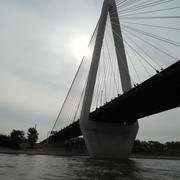Due to a lapse in appropriations, the majority of USGS websites may not be up to date and may not reflect current conditions. Websites displaying real-time data, such as Earthquake and Water and information needed for public health and safety will be updated with limited support. Additionally, USGS will not be able to respond to inquiries until appropriations are enacted. For more information, please see www.doi.gov/shutdown
Central Midwest Water Science Center
Home
Welcome to the Central Midwest Water Science Center’s (CMWSC) Website. We offer information on streamflow, water quality, water-use, and groundwater data for Illinois, Iowa, and Missouri. We conduct unbiased, scientific hydrologic investigations & research projects to effectively manage CMWSC and our Nation's water resources through joint efforts with our partners.
News
USGS Flood Experts Respond to High Water in Central, Northeastern U.S.
Crews from the U.S. Geological Survey have been in the field for weeks measuring flooding in the Midwest and in the Mississippi River watershed, and more recently flooding and storm tides on the Northern Atlantic coast, as higher temperatures, heavy rain, snowmelt and nor’easters affected numerous states.
New Report on Channel Bed Erosion Helps Assess Bridge Stability in St. Louis
A new assessment of channel bed erosion near 13 highway bridges in the greater St. Louis, Missouri, area is now available in an online report from the U.S. Geological Survey, produced in cooperation with the Missouri Department of Transportation.
Red Dye Study Will Examine Water Flow through Auxiliary Lock 14 near the Quad Cities
U.S. Geological Survey scientists will inject a harmless, bright red fluorescent dye into the auxiliary lock at Locks and Dam 14 on the Mississippi River near Pleasant Valley, Iowa, Tuesday, June 13, 2017, weather permitting. If needed, a backup date is scheduled for June 27, 2017.
Publications
Distribution of mining-related trace elements in streambed and flood-plain sediment along the middle Big River and tributaries in the Southeast Missouri Barite District, 2012–15
Lead mining first began in the Big River watershed during the 1700s. Lead was the primary metal mined throughout most of the 1700s and early 1800s and it continued to be mined until the mid-1900s. Barite mining began in the middle part of the watershed in the mid- to late 1800s. Although considerable attention has been given to concentrations of...
Smith, David C.; Schumacher, John G.Assessment of water resources in areas that affect the habitat of the endangered Hine’s emerald dragonfly in the Lower Des Plaines River Valley, Illinois
Review of previous investigations indicates that potential decreases in groundwater recharge and increased groundwater extraction in the vicinity of the Lower Des Plaines River Valley in Will County, Illinois, may reduce the amount of groundwater flow in the Silurian aquifer in this area. Groundwater discharge from the Silurian aquifer to wetlands...
Kay, Robert T.; Gahala, Amy M.; Bailey, ClintonTransport of nitrogen and phosphorus in the Cedar River Basin, Iowa and Minnesota, 2000–15
Nitrate concentrations in the Cedar River in Iowa and Minnesota have increased from an average of less than 1.0 milligram per liter in the early 1900s to more than 5.0 milligrams per liter in the 2000s and have resulted in periodic water-quality impairment of the river. Spatial differences and temporal changes in nitrogen and phosphorus transport...
Kalkhoff, Stephen J.








